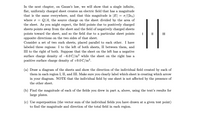Question
Answer all parts of the physics problem

Transcribed Image Text:In the next chapter, on Gauss's law, we will show that a single infinite,
flat, uniformly charged sheet creates an electric field that has a magnitude
that is the same everywhere, and that this magnitude is |E|
0/(260)
Q/A, the source charge on the sheet divided by the area of
where o
the sheet. As you might expect, the field points due to positively charged
sheets points away from the sheet and the field of negatively charged sheets
points toward the sheet, and so the field due to a particular sheet points
opposite directions on the two sides of that sheet.
Consider a set of two such sheets, placed parallel to each other. I have
labeled three regions: I to the left of both sheets, II between them, and
the right of both. Suppose that the sheet on the left has a negative
surface charge density of -6.0 C/m2 while the sheet on the right has a
positive surface charge density of +9.0 C/m2.
III
III
(a) Draw a diagram of the sheets and show the direction of the individual field created by each of
them in each region I, II, and III. Make sure you clearly label which sheet is creating which arrow
in your diagram. NOTE that the individual field by one sheet is not affected by the presence of
the other sheet.
(b) Find the magnitude of each of the fields you drew in part a, above, using the text's results for
large plates.
(c) Use superposition (the vector sum of the individual fields you have drawn at a given test point)
to find the magnitude and direction of the total field in each region.

Transcribed Image Text:II
Expert Solution
This question has been solved!
Explore an expertly crafted, step-by-step solution for a thorough understanding of key concepts.
Step by stepSolved in 3 steps with 3 images

Knowledge Booster
Similar questions
arrow_back_ios
SEE MORE QUESTIONS
arrow_forward_ios